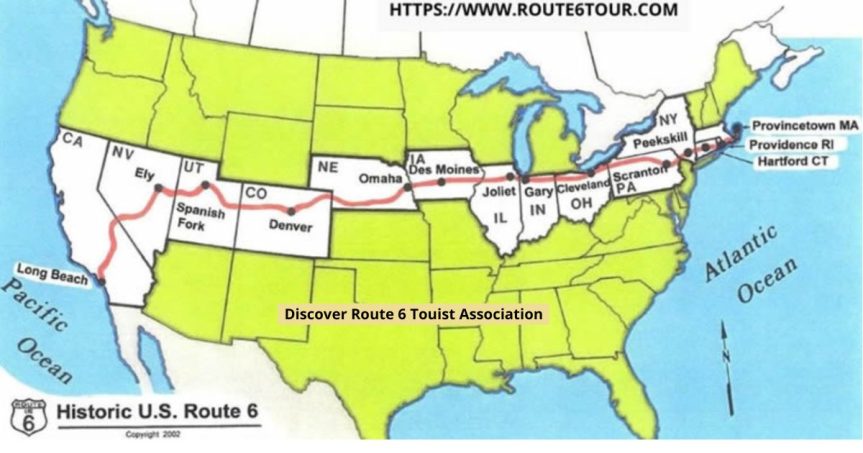The Magic of Route 6 in Illinois
Imagine a road trip where every mile unravels a piece of American history, stories of pioneers, and the legacy of an evolving nation. Welcome to Route 6 in Illinois, an often-overlooked treasure trove of American heritage that promises an adventurous blend of history and culture. Stretching across the state, this iconic highway invites history buffs, local communities, tourists, and road trip enthusiasts to explore and preserve its rich legacy.
In this content, we’ll take a deep dive into the history of Route 6, uncover key landmarks, and provide tips for an unforgettable exploration. Let’s hit the road and rediscover America’s past on Route 6 in Illinois.
The Historical Backbone of Route 6
Route 6, also known as the Grand Army of the Republic Highway, holds a special place in the history of the United States. Initially conceived in the 1920s as part of the nation’s first highway system, Route 6 spans from Massachusetts to California, cutting through the heart of Illinois. It was designed to connect small towns and big cities, providing an essential route for commerce, travel, and communication.
In Illinois, Route 6 played a pivotal role in the development of the state, linking agricultural communities and promoting trade. During World War II, it became a crucial supply route, earning its name in honor of the Union Army veterans. This historical significance makes Route 6 more than just a road; it’s a living testament to the growth and resilience of America.
Must-See Landmarks Along Route 6
Joliet’s Rich Industrial Legacy
Joliet, often referred to as the “City of Steel,” is a must-see stop along Route 6. Once a bustling industrial hub, Joliet is home to historic sites like the Joliet Iron Works and the Joliet Area Historical Museum. These landmarks offer a glimpse into the city’s industrial past and its contributions to America’s growth.
Visitors can explore the remnants of the iron works, walk through the museum’s exhibits, and learn about the city’s transformation from an industrial powerhouse to a thriving cultural center. Joliet’s rich history is a testament to the enduring spirit of American industry.
Ottawa’s Historical Charm
Nestled along Route 6, the charming town of Ottawa boasts a wealth of historical landmarks. The Reddick Mansion, a stunning Italianate structure, stands as a symbol of the 19th-century architectural elegance. Visitors can take guided tours of the mansion, exploring its meticulously preserved rooms and learning about its significance in local history.
Ottawa is also home to Washington Square Park, where the first Lincoln-Douglas debate took place in 1858. This historic event marked a turning point in American politics, and the park now features statues commemorating Lincoln and Douglas, inviting visitors to reflect on their legacy.
Starved Rock State Park
For nature lovers and history enthusiasts alike, Starved Rock State Park is a gem along Route 6. Known for its awe-inspiring canyons, waterfalls, and hiking trails, the park also holds historical significance. Native American tribes once inhabited the area, leaving behind a rich cultural heritage.
Visitors can explore the park’s natural beauty, take guided tours to learn about its history, and even visit the Starved Rock Lodge, a historic lodge built in the 1930s. The park offers a unique blend of natural wonders and historical insights, making it a must-visit destination on Route 6.
The Role of Community and Tourism
Preserving Heritage Through Community Involvement
The preservation of Route 6’s historical sites relies heavily on community involvement. Local organizations, historical societies, and passionate individuals come together to maintain and promote these landmarks. Their efforts ensure that future generations can experience and appreciate the rich history of Route 6.
Community events, fundraisers, and educational programs play a crucial role in raising awareness and garnering support for preservation efforts. By actively participating in these initiatives, locals contribute to the ongoing preservation of their heritage.
The Impact of Tourism
Tourism is a vital component in preserving the historical sites along Route 6. When tourists visit these landmarks, they contribute to the local economy and generate funds for maintenance and restoration projects. Tourism also raises awareness about the significance of these sites, encouraging more people to support preservation efforts.
By promoting Route 6 as a historical and cultural destination, tourism helps ensure that these landmarks receive the attention and care they deserve. Visitors play a crucial role in keeping the history of Route 6 alive and thriving.
Exploring Route 6: Practical Tips and Recommendations
Planning Your Trip
Exploring Route 6 requires careful planning to make the most of your adventure. Start by mapping out your route and identifying key landmarks you want to visit. Researching historical sites, accommodation options, and dining establishments ahead of time can help you create a seamless itinerary.
Consider joining guided tours or attending local events to gain deeper insights into the history and significance of Route 6. These experiences can enhance your understanding and appreciation of the sites you visit.
Suggested Itineraries
To help you get started, here are a few suggested itineraries for exploring Route 6:
Day Trip: Begin your day in Joliet, visiting the Joliet Iron Works and Joliet Area Historical Museum. Continue to Ottawa to explore the Reddick Mansion and Washington Square Park. End your day with a hike at Starved Rock State Park.
Weekend Getaway: Spend a weekend immersing yourself in the history and natural beauty of Route 6. Start in Joliet, then head to Ottawa and Starved Rock State Park. Extend your trip to include nearby towns like LaSalle and Peru, each offering unique historical sites and attractions.
Week-Long Adventure: For a more immersive experience, take a week to explore Route 6 in its entirety. Visit all the key landmarks, engage with local historians, and take your time to savor the beauty and history of the region.
Places to Stay
Finding the right accommodation is essential for a comfortable and enjoyable trip. Route 6 offers a variety of lodging options, from historic inns to modern hotels. Consider staying at the Starved Rock Lodge for a unique experience, or explore charming bed-and-breakfasts in towns like Ottawa and LaSalle.
Booking accommodations in advance, especially during peak travel seasons, ensures you have a place to rest after a day of exploration. Researching reviews and amenities can help you choose the best lodging options for your needs.
The Importance of Protecting Route 6
Preserving the historical sites along Route 6 is not just about protecting buildings and landmarks; it’s about safeguarding our shared heritage. These sites tell the story of America’s growth, resilience, and cultural evolution. By visiting and supporting these landmarks, we contribute to their preservation for future generations.
Encouraging others to explore Route 6 and learn about its history helps raise awareness and generate support for preservation efforts. Whether through social media, travel blogs, or word-of-mouth, sharing your experiences can inspire others to join the cause.
Share Your Journey
We invite you to share your experiences on Route 6 and contribute to the ongoing conversation about preserving American heritage. Whether you’re a history buff, a local resident, or a road trip enthusiast, your stories and insights are valuable.
Join our online community, share your photos and stories, and connect with fellow explorers who share your passion for history and adventure. Together, we can ensure that the legacy of Route 6 continues to thrive for generations to come.
Conclusion
Route 6 in Illinois is more than just a highway; it’s a living testament to America’s history and heritage. From industrial hubs to charming towns and natural wonders, Route 6 offers a unique blend of cultural and historical experiences. By exploring and supporting these landmarks, we contribute to their preservation and ensure that future generations can appreciate their significance.
Whether you’re a seasoned traveler or a first-time explorer, Route 6 welcomes you to discover the stories, people, and places that have shaped our nation’s history. Let’s hit the road, uncover hidden gems, and keep the spirit of Route 6 alive for years to come.



